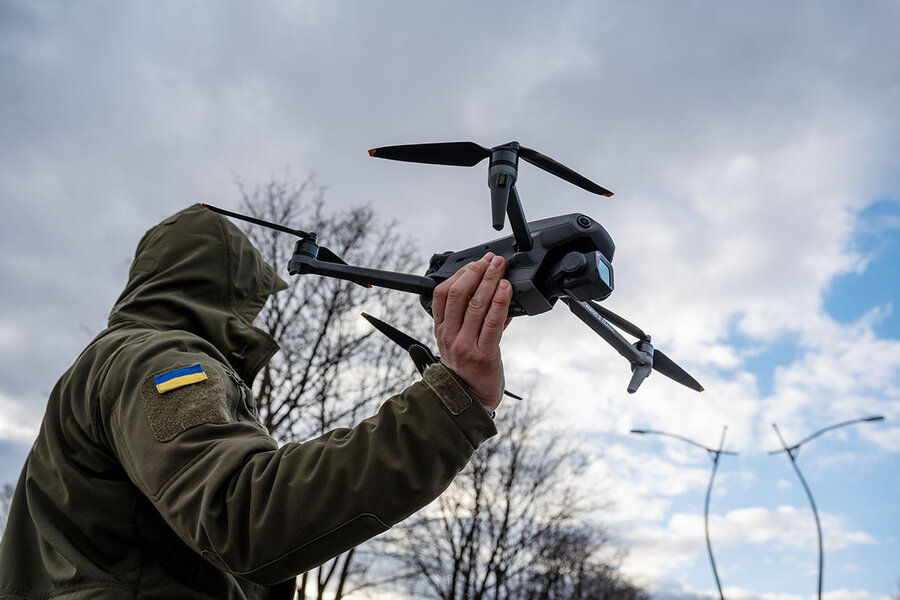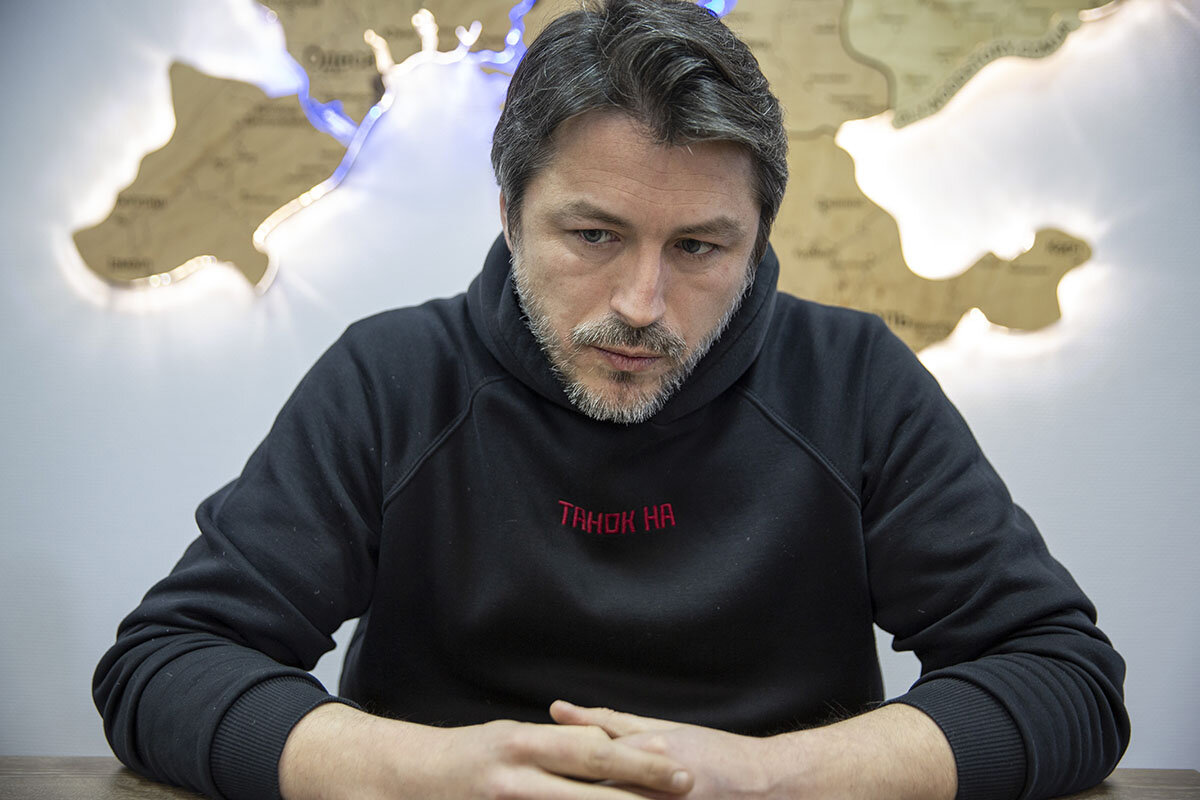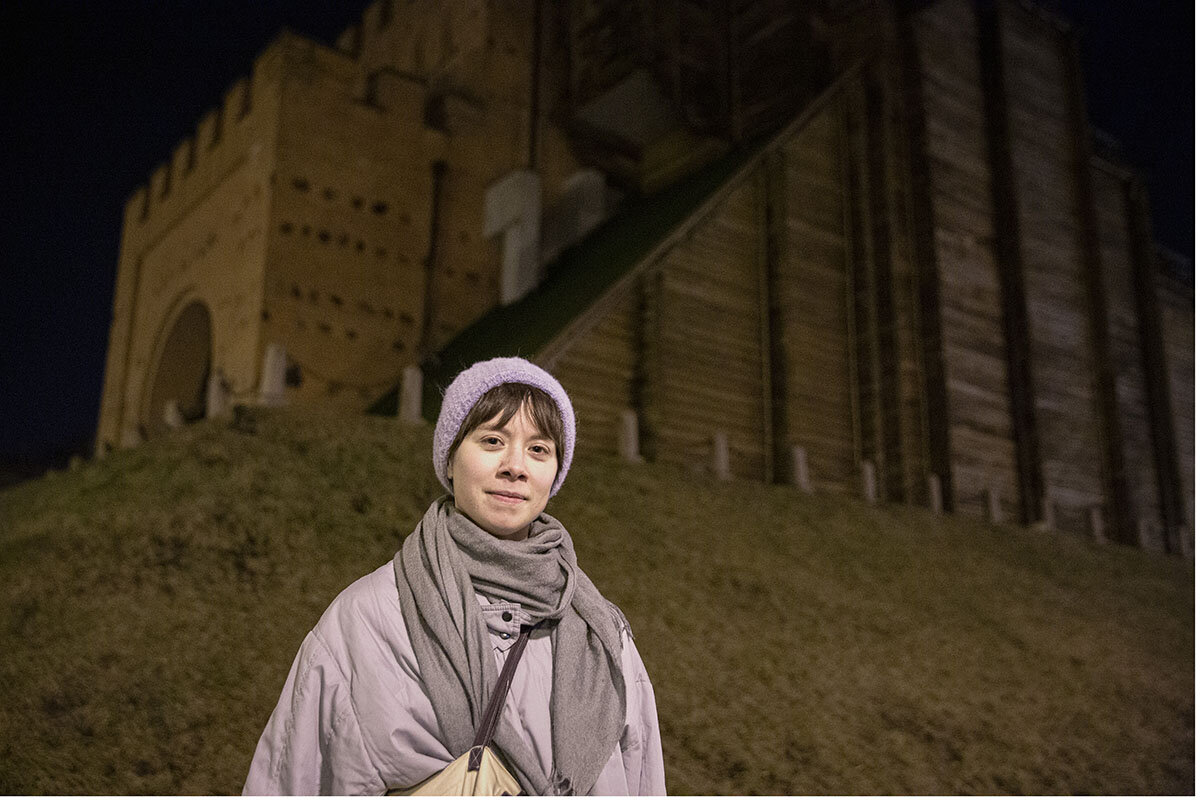From citizens’ pockets to soldiers’ hands: Ukraine’s crowdfunded war
Loading...
| Kyiv, Ukraine
A yellow brick building in a residential neighborhood of Kyiv operates much like a retail warehouse. Orders arrive via forms filled out online. Volunteers neatly pack the day’s deliveries into cardboard boxes affixed with large white labels announcing their contents and intended destinations.
The recipients are primarily Ukrainian soldiers and volunteer fighters locked in battle with Russian forces in the east of the country. The items being packed, from drones to rifle scopes to satellite telephones, have been bought for them by members of the public. So have armored personnel carriers, but they do not fit in the boxes.
Call it combat crowdfunding.
Why We Wrote This
A story focused onCitizen crowdfunding quickly became a trademark of the war in Ukraine. That solidarity has given noncombatants a way to serve the nation and those fighting reassurance that they are supported.
“This is about Ukrainian unity,” says Serhiy Prytula, coffee mug in hand. He heads the foundation that runs this depot, keeping the front lines supplied. It has raised over $100 million from the public to help supply the Ukrainian army and intelligence services with military equipment. “We are talking about total war.”
A cursory glance around the front room reveals the variety of supplies that are sent out free of charge: two drones destined for one brigade, a Starlink internet module for another; two generators and thermal vision gear for a Special Forces regiment; and countless Lenovo tablets loaded with software used to coordinate artillery fire.
Tank antennas, power banks, and rifle scopes fill a back room. The group makes anywhere from three to 15 deliveries daily to different parts of Ukraine.
Mr. Prytula, a former TV host and actor whose epic military fundraising efforts have turned him into a household name, is both tired and upbeat. He has just returned from a trip to Lviv, near the Polish border, where he had collected a batch of 24 armored personnel vehicles.
It had taken less than two days to raise the $6.5 million needed to pay for them, which Mr. Prytula calls “another example of there is no such thing as impossible in the Ukrainian language.”
Crowdfunding has become a way of life in wartime Ukraine. Those fighting in the front may be far away, but they are not forgotten in Kyiv. Billboard campaigns urge citizens to fund the war effort. Opening any social media app, such as Instagram; the messaging app Telegram; or ride-sharing platforms, such as BlaBlaCar, prompts a request to donate to the troops.
And in a country where the ease and sophistication of digital financial transactions eclipse the rest of Europe, it takes just a click or a swipe to give.
“It’s not a ‘should’”
Normally, the Ukrainian military would provide its soldiers with all the arms and supplies they need in the field. But with the unexpectedness of Russia’s invasion last year, combined with the desperation of Ukraine’s defense, the number – and corresponding needs for materiel – of Ukraine’s soldiers quickly ballooned beyond the state’s ability to equip them.
Enter the crowdfunders. Fundraising campaigns to support the war effort have come in all shapes and sizes. Ukrainian President Volodymyr Zelenskyy’s United24, the official fundraising platform, has raised over $302 million from private and corporate donors at home and abroad, an effort audited by Deloitte. The Serhiy Prytula Charity Foundation, one of the country’s largest, has raised $114 million, with Ukrainians accounting for the bulk of contributions. And then there are individual collections, which range from the regular to sporadic.
The practice for some is as regular as a morning coffee or a monthly paycheck (for those who still get one). The seemingly endless giving is rooted in an unprecedented national unity as much as a shared sense of responsibility. Not everyone is fighting or willing to do so, but everyone is invested in a decisive military victory over Russia. The consistency of the generosity helps lift the spirits of soldiers who are not just risking life and limb but also constantly needing to repair and replace their equipment.
“When I get paid, I donate 10% of my salary,” says Sasha Yatzivo, a software front-end developer, wrapped against the evening chill in a black coat and floral scarf. Her money typically goes to finance the efforts of a friend who puts together packs of medical supplies for soldiers. “It is the right thing to do. Our armed forces need our support to deliver victory as soon as possible. It’s not a ‘should.’ ... I have to do it.”
“It’s more than crowdfunding,” says Dmytro Sidelnyk, a motion graphics designer dragging his dog on an uphill night walk in the capital. “We are fighting for our lives and our values. We don’t want to live in tyranny and in fear.”
He used to live in New Zealand, but love of country brought him back to Ukraine during the COVID-19 pandemic. Now he participates in fundraising neighborhood runs for the army and donated 50% of his earnings from summer online classes to support the war effort. “Our society works like a hive, like bees,” he reflects. “We have small groups that can do things independently, make decisions independently.”
“It means we don’t feel abandoned”
The willingness to chip in cuts across generations and budgets. Kateryna Smirnova, a young freelance theater actress and traditional singer, says her social circles might not be flush with cash, but everyone chips in small amounts regularly.
“I really appreciate the campaigns that say that 15 hryvnia [41 cents] per day is still a lot,” she says. “If thousands do it, it matters. We have to survive ourselves, but we all have to contribute somehow.” She herself budgets $40 per month for donations, but emotional appeals by her friends – such as one trying to get night vision goggles for her dad serving on the front – mean she often goes over.
Having a personal connection is crucial for smaller campaigns. Tamila Selina, a middle-aged music teacher, wants to know exactly to whom her money is going. During the last crowdfunding campaign, she donated $50 to help repair the drone of her colleague’s son serving in the army. “They gathered all the money in just one day,” she says with a sense of marvel.
Dmytro Onga Kornilov, an Odesa native who has tapped into the global NFT digital art community to raise thousands of dollars to purchase tactical gear, says that it’s important to do the research to make sure you’re supplying the right gear to the right troops. Otherwise, the civilian-to-soldier supply lines can miss the mark. “You need to check military requests. Does the unit exist and actually need what is being requested? Only then you start making arrangements,” he says. “Your main resource is your reputation. You can only get it wrong once. It is all about trust.”
Crowdfunding campaigns by civil society help relieve pressure on the government. It’s less effective for the state to spend time buying 150,000 helmets when it needs to focus on securing tanks and high-grade military equipment, argues Mr. Kornilov. That means that civilians like him need to develop expertise. “To do your job properly as a volunteer you need to dive into the details of what you are procuring,” he says.
That kind of care is highly appreciated by men on the front. “The most important aspect about this crowdfunding help is the consistency,” says Oleksiy Bilkovskiy, who is part of a nationalist paramilitary group that was absorbed into the Armed Forces of Ukraine. “It is not a one-off. The flow doesn’t stop and that is key because there are so many expendables. It means we don’t feel abandoned. We feel that this whole engine of resiliency is working around us.”
Oleksandr Naselenko supported reporting for this story.









